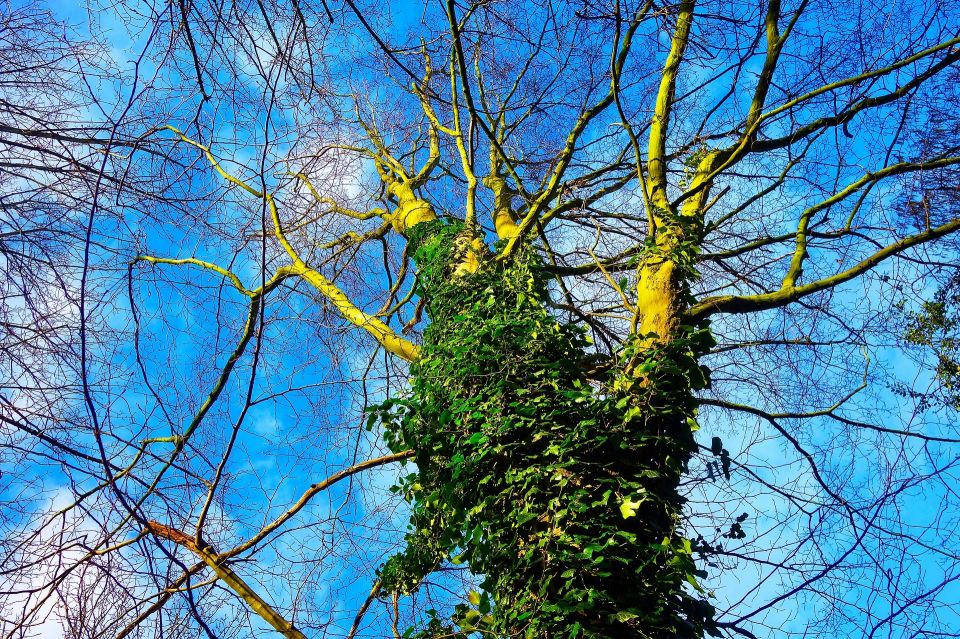Get rid of Thick Ivy on Trees
Trees are not just gorgeous and fundamental parts of our regular habitat, yet they additionally give various advantages, including oxygen creation, air cleansing, and environment for natural life. Tragically, trees in many scenes are under danger from a typical trespasser: thick ivy.
Ivy, while frequently respected for its rich green appearance, can turn into an impressive enemy when it overwhelms trees. Thick ivy scaling the trunks and parts of trees might appear to be pleasant, however it can present serious dangers to their wellbeing and underlying respectability. In this blog entry, we’ll dive into the issue of thick ivy on trees, investigating the justifications for why it’s risky and the way in which you can actually address this worry.
Eliminating thick ivy from trees isn’t just a stylish pursuit; it’s an urgent move toward guaranteeing the life span and imperativeness of your trees. Here are a few justifications for
Understanding the Ivy Issue
Ivy comes in different species, yet the most widely recognized types that will quite often climb trees are English ivy (Hedera helix) and Boston ivy (Parthenocissus tricuspidata). Both of these ivy species can develop quickly and become thick, making them especially problematic for trees. Ivy moves by utilizing specific cement cushions on its elevated roots. These roots connect themselves to the tree’s covering and, over the long run, can enter the bark and arrive at the hidden wood. This connection component permits ivy to stick to trees and designs so really. Ivy can impede daylight from arriving at a tree’s leaves. This decrease in daylight restricts the tree’s capacity to photosynthesize and produce energy, which is fundamental for its development and in general wellbeing. The additional load of ivy on branches can prompt primary precariousness. In extreme cases, this can make branches break or even result in the removal of the tree.
Environment for Vermin: Thick ivy can make a microclimate that harbors irritations and infections harmful to the tree. It can likewise discourage valuable bugs and birds.
Contest for Assets: Ivy rivals trees for water and supplements in the dirt, further focusing on the tree.
Trees shrouded in ivy might display indications of decline, including yellowing leaves, decreased development, and by and large chronic weakness. The heaviness of ivy can make branches more powerless to breakage, particularly during tempests or weighty breezes. Ivy can establish a protected climate for bugs and infections that can hurt the tree, like aphids, scale bugs, and parasitic microorganisms. Congested ivy can make security risks by covering feeble or rotting branches that might fall suddenly.
Techniques to get rid of thick ivy on trees
Whenever you’ve distinguished the sort of ivy on your trees, surveyed the degree of ivy inclusion, and assessed the strength of the impacted trees, now is the ideal time to think about the techniques for eliminating thick ivy.
Manual Expulsion
1. Devices and Hardware Required:
- Gloves for hand security
- Hand pruners or loppers for cutting ivy stems
- Garden shears or scissors for managing leaves
- A tough stepping stool for arriving at high branches
- A canvas or drop material for gathering ivy garbage
- Security goggles for eye assurance
2. Bit by bit Cycle for Manual Evacuation:
Begin at the Base: Start by cutting and eliminating the ivy at the foundation of the tree. Cut the ivy stems at ground level, guaranteeing you cut off the association between the ivy and the roots.
Pull Away Ivy: Cautiously pull the ivy away from the tree’s trunk and branches. Assuming the ivy is excessively thick, you might have to utilize pruners or scissors to remove it in reasonable segments.
Eliminate Ivy Starting from the earliest stage: Keep on eliminating ivy starting from the earliest stage the tree for a few feet to keep it from reattaching and climbing once more.
Discard Ivy: Gather all cut ivy and put it on a covering or drop fabric. This keeps the ivy from re-establishing in your nursery. Discard it appropriately; try not to compost it.
Screen and Rehash: Routinely examine the tree for any ivy regrowth and eliminate it instantly.
Substance Control
1. Choosing the Right Herbicides:
Glyphosate-based herbicides are viable for killing ivy. Guarantee you pick an item that is ok for use around trees and adhere to the producer’s guidelines.
2. Application Strategies and Security Precautionary measures:
Timing: Apply the herbicide when the ivy is effectively developing and not during outrageous intensity or cold.
Showering: Utilize a nursery sprayer to apply the herbicide to the ivy’s leaves. Be mindful so as not to overspray onto the tree’s foliage.
Cut and Treat: For thick ivy, think about cutting the ivy plants close to the base, and afterward apply the herbicide straightforwardly to the cut closures. This takes into consideration more effective assimilation.
Security Stuff: Wear defensive dress, gloves, wellbeing goggles, and a veil while dealing with herbicides. Keep all wellbeing safeguards and rules on the herbicide name.
Discard Herbicide Holders: Discard herbicide holders as indicated by nearby guidelines.
Mechanical Expulsion
1. Utilizing Power Apparatuses:
Power apparatuses like trimming tools or pruning shears can be utilized to slice through thick ivy plants and eliminate them from the tree. This strategy is compelling for enormous, laid out ivy development.
2. Advantages and disadvantages of Mechanical Evacuation:
Pros: Speedy and effective, particularly for thick ivy. Diminishes the gamble of herbicide use. Can be less work serious.
Cons: May harm tree husk on the off chance that they are not utilized cautiously. Requires specific hardware and skill.
- How To Remove a Palm Tree Stump by Hand
- How to Remove Seed Pods from Palm Trees
- How to remove vines from tall trees
Natural Control
1. Prologue to Utilizing Regular Hunters:
A few bugs and creatures feed on ivy, which can assist with controlling its development normally. For instance, particular sorts of birds, like cedar waxwings, may consume ivy berries.
2. Contemplations for Presenting Regular Foes:
Presenting normal hunters ought to be done warily and with thought for the neighborhood biological system. Talk with nearby natural life specialists or biologists prior to endeavoring this technique.
Every one of these ivy expulsion techniques enjoys its benefits and restrictions. The decision of technique ought to be founded on the particular attributes of the ivy pervasion, tree wellbeing, and your own inclinations. No matter what the technique picked, ordinary checking and upkeep are vital to keeping ivy from returning.
Aftercare
- Checking the Tree’s Wellbeing After Ivy Evacuation
- Forestalling Future Ivy Development
- Pruning and Really focusing on the Tree
FAQs
Is ivy unsafe to trees?
Indeed, thick ivy can be unsafe to trees as it goes after supplements, water, and daylight. It can debilitate trees, making them more defenseless to illnesses and bugs.
Might I at any point essentially remove the ivy from the tree’s trunk?
While removing ivy the storage compartment is a critical stage, eliminating it from the roots too is fundamental. Cutting the ivy at the base and eliminating it cautiously is the best method for forestalling regrowth.
When is the best chance to eliminate ivy from trees?
The best time for ivy expulsion is during the torpid season, normally in pre-winter or winter. During this time, the tree is less dynamic, making it more straightforward to deal with ivy evacuation without causing extra pressure.
Are there eco-accommodating techniques for ivy expulsion?
Indeed, eco-accommodating techniques for ivy evacuation incorporate manual expulsion, specific herbicides, and advancing local plant development. These strategies limit damage to the climate and untamed life.
How would it be advisable for me to respond on the off chance that the ivy invasion is extreme or the tree is undesirable?
In extreme cases or on the other hand in the event that the tree is as of now compromised, it’s fitting to counsel a confirmed arborist or expert tree care administration. They can survey what is happening and suggest the best game-plan.
Conclusion
In your excursion to eliminate thick ivy from trees, you’ve found out about the difficulties ivy postures to tree wellbeing, the means for protected and powerful evacuation, as well as elective strategies and contemplations. Begin by surveying the degree of ivy inclusion on the tree and its general wellbeing. Painstakingly cut the ivy at the foundation of the tree to cut off its association with the roots. Tenderly strip the ivy away from the tree’s husk, taking consideration not to harm it. Gather the cut ivy and discard it appropriately. Clean the region around the tree. Screen the tree’s wellbeing, forestall future ivy development, and care for the tree through standard pruning and upkeep. Recall that the essential objective of ivy evacuation is to reestablish and keep up with the strength of your trees. Thick ivy can debilitate trees, making them more helpless to sicknesses and irritations. By following the means illustrated in this aide and focusing on long haul care, you can allow your trees the best opportunity to flourish. Dependable ivy evacuation reaches out past your nearby tree care endeavors.




